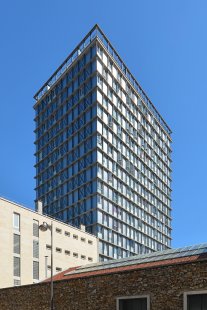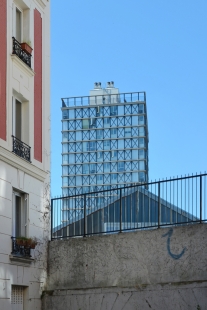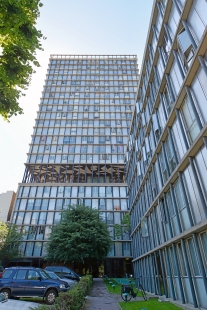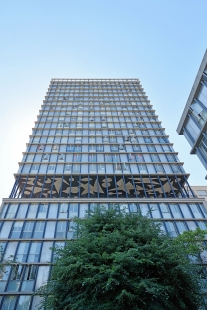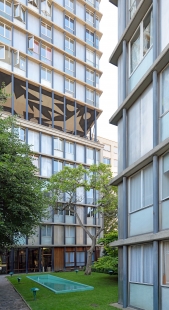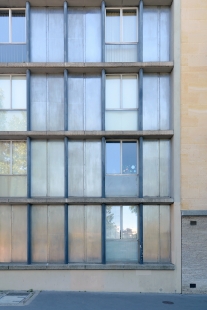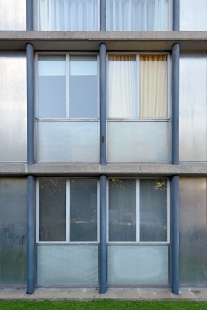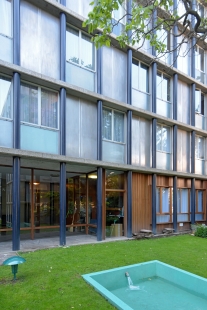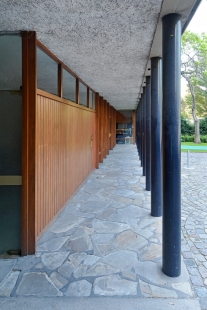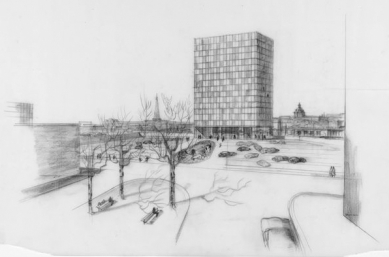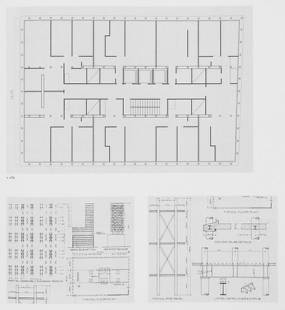
Tour Croulebarbe
<translation>Tour Albert</translation>

The high-rise building in the 13th arrondissement of Paris, named after the street (Rue de Croulebarbe) or its architect (Édouard Albert), is the first skyscraper built within the city limits of the Boulevard périphérique. Before that, some buildings attempted to elevate the Parisian skyline, but until World War II, only the Eiffel Tower and the towers of cathedrals stood out. The 65-meter residential tower Tour Croulebarbe was then surpassed more than threefold in 1973 by the administrative tower Tour Montparnasse, and subsequently, the city's leadership decided to concentrate all high-rise buildings outside the city in the La Défense district.
The residential tower Tour Albert, resulting from the structural rationalism of engineer Jean-Louis Sarf, reveals external load-bearing steel columns and cross-bracing that protrude in front of the façade made of prefabricated metal panels. Hollow steel pipes with a diameter of 20 cm were filled with a concrete mixture for increased load-bearing capacity. The innovative façade with translucent parapets and stainless-steel panels later caused kinetic issues. The building was the subject of many legal disputes, and to enhance fire safety, it had to be modified afterward.
The entire sixth floor, covering 600 m², serves as a lookout platform for the residents of 110 apartments, initially intended to be accessed via a wide pedestrian promenade directly from Place d'Italie square. The publicly accessible ramp was ultimately not built (RATP rejected the bridge over the tracks to the maintenance station), nor was a new housing estate with hundreds of apartments designed by the trio of architects Albert, Boileau, and Labourdette. The ceiling of the observation floor features an abstract black-and-white painting by Jacques Lagrange (who was, among other things, a co-screenwriter for films by Jacques Tati). Another terrace for the building's residents is located on the 22nd floor. At the initiative of Anne Coutine (the daughter of Édouard Albert), the building was declared a historical monument in 1994 and underwent a total renovation in 2005 under the guidance of the Gorka Piqueras studio.
Directly opposite Tour Croulebarbe stands the significant interwar building Mobilier National (the administration of state furniture and tapestries) designed by Auguste Perret in 1937.
The residential tower Tour Albert, resulting from the structural rationalism of engineer Jean-Louis Sarf, reveals external load-bearing steel columns and cross-bracing that protrude in front of the façade made of prefabricated metal panels. Hollow steel pipes with a diameter of 20 cm were filled with a concrete mixture for increased load-bearing capacity. The innovative façade with translucent parapets and stainless-steel panels later caused kinetic issues. The building was the subject of many legal disputes, and to enhance fire safety, it had to be modified afterward.
The entire sixth floor, covering 600 m², serves as a lookout platform for the residents of 110 apartments, initially intended to be accessed via a wide pedestrian promenade directly from Place d'Italie square. The publicly accessible ramp was ultimately not built (RATP rejected the bridge over the tracks to the maintenance station), nor was a new housing estate with hundreds of apartments designed by the trio of architects Albert, Boileau, and Labourdette. The ceiling of the observation floor features an abstract black-and-white painting by Jacques Lagrange (who was, among other things, a co-screenwriter for films by Jacques Tati). Another terrace for the building's residents is located on the 22nd floor. At the initiative of Anne Coutine (the daughter of Édouard Albert), the building was declared a historical monument in 1994 and underwent a total renovation in 2005 under the guidance of the Gorka Piqueras studio.
Directly opposite Tour Croulebarbe stands the significant interwar building Mobilier National (the administration of state furniture and tapestries) designed by Auguste Perret in 1937.
The English translation is powered by AI tool. Switch to Czech to view the original text source.
0 comments
add comment



